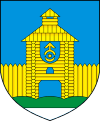Dzyatlava
|
Dziatlava Дзятлава |
|||
|---|---|---|---|

Catholic Church of the Assumption of Mary founded by Sejm Marshal Lew Sapieha
|
|||
|
|||
| Location of Hrodna | |||
| Coordinates: 53°27′N 25°24′E / 53.450°N 25.400°E | |||
|
Country Subdivision |
Belarus Hrodna voblast |
||
| Founded | 1498 | ||
| Population (2004) | |||
| • Total | 8 300 | ||
| Time zone | FET (UTC+3) | ||
| • Summer (DST) | not observed (UTC+3) | ||
| Area code(s) | +375-15 | ||
| Website | Dzyatlava Dyatlovo | ||
Dziatlava (Belarusian: Дзятлава, Lithuanian: Zietela, Polish: Zdzięcioł, Russian: Дятлово, Yiddish: זשעטל Zhetl) is a town in Belarus in the Hrodna voblast, about 165 km southeast of Hrodna. The population was 7,700 in 2016.
Dziatlava (Zdzięcioł) was first referenced in documents from 1498, when it was granted by the King of Poland John I Albert to Prince Konstanty Ostrogski of Polish–Lithuanian Commonwealth, who later built a wooden castle there. In the 17th century the settlement was owned by Lew Sapieha, who ordered a Catholic church to be erected on the main city square. The church was consecrated in 1646, renovated after a fire in 1743 and still stands. During the Great Northern War of the anti-Swedish alliance, Peter I of Russia visited Dzyatlava and stayed there for a week in January 1708. In the 18th century, the town was owned by Polish magnate Stanisław Sołtyk, who built a Baroque residence there in 1751.
Until World War II, Zdzięcioł (now Dziatlava) belonged to the eastern part of the Second Polish Republic. It was the seat of Gmina Zdzięcioł in Nowogródek Voivodeship. The population was composed predominantly of Polish Jews. The Soviet forces invaded eastern Poland on September 17, 1939, and stationed in the Voivodeship area until the outbreak of their own war with Germany in June 1941. After the Soviet rapid retreat, and several months of Nazi ad hoc persecution, on February 22, 1942 the new German authorities officially created Zdzięcioł Ghetto.
...
Wikipedia



